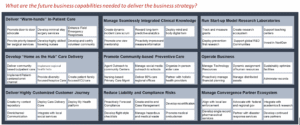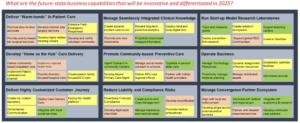What Is A Business Capability Model?
By Betsy Burton
What Is A Business Capability Model?
After last week’s blog (How Do You Model Business Transformation?), I received several questions about a business capability model, and what one really looks like.
The reality is, I could do a whole years’ worth of notes, blogs, and presentations just on this topic. But let me try to give you a bit of an overview in this blog.
Business Capability
I first heard about a business capability model when I was working with a number of clients several years ago. When I started doing research on the topic, I started finding a couple of definitions that I thought were interesting.
The strongest that I’ve seen so far from an external source is from a professor at Boston University:
| A business capability is a distinctive attribute of a business unit that creates value for its customers. Capabilities are measured by the value generated for the organization through a series of identifiable cash flows. Thus, capabilities differentiate an organization from others and directly affect its performance.
Source: “Managing Information Technology Investments Using a Real-Options Approach” by P. Balasubramanian, N. Kulatilaka, J. Storck, School of Management, Boston University |
I have since tried to clarify that definition a bit on my own:
| Business capability modeling is a technique for illustrating/representing an organization’s future-focused business strategy, independent of the org structure, processes, people or domains. Its purpose is to inform and guide decision-making.
Source: Betsy Burton, Aragon Research |
The real nut of these definitions is that business capability modeling is a way of modeling the future state of your business and your business strategy in a way that’s abstracted from all the details of how you operate your business.
The benefit of business capability modeling is that you can explore your future state in a way that is unencumbered by political issues related to domains, organizational structure, processes, or functions.
What Does a Business Capability Model Look Like?
I’ve created this semi fictitious business capability model to illustrate what a business capability model could look like. In this case I’m using a very large regional health care provider organization as my example.
In this case study example, the organization’s business strategy is to increase quality of care and decrease costs by promoting hyper-local preventative care, dynamic incident and research scrums, end-to-end patient care and regionalized partners.

The key is that the business capability model must be driven by the business strategy and must reflect the future-state capabilities needed to support that strategy.
How to Use Business Capability Model to Guide Business Transformation
By themselves, business capability modeling can be interesting to strategic planners and business architects, and (honestly) probably few others.
However, business capability modeling can be very interesting if used to address the specific questions of senior executives, and business and IT leaders.
Say for example, your senior executive would like to understand where your business needs to make investments.
You could use a business capability model to illustrate what future-state capabilities are commodity, differentiated or innovative.

Then you can start to have some interesting discussions.
Do we really need to invest in modernizing or transforming applications that are supporting commodity capabilities in the future? Probably not.
We do need to invest in innovative solutions and business models that enable innovative capabilities in the future.
Bottom Line
This is honestly a quick overview of business capability modeling, intended to give you an idea of the potential value and impact of this technique.
If you are interested in this topic, please let us know by dropping a note to info@aragonresearch.com. If there is interest, we are happy to write, blog and present more on this topic.
The key about business capability modeling is that it is an organization-, domain-, and function-neutral way for exploring, understanding and communicating about your future-state business with the goal of informing investment decisions.
I personally get excited about it because it is an opportunity for executives, leaders and architects to think creatively about their potential future without the political infighting that can occur.
P.S. If you ever have questions about this or need a business capability model reviewed, please feel free to schedule an inquiry with me:

This blog is a part of the Business Transformation blog series by Aragon Research’s VP of Research, Betsy Burton.
Missed the previous installments? Catch up here:
Blog 1: Betsy Burton Brings You a New Blog Series on Business Transformation
Blog 2: What Are the Benefits of Supporting Business Architecture?
Blog 3: How Do Business Architects Gain and Retain Management Support?
Blog 4: How Do We Find and Recruit Great Business Architects?
Blog 5: Is a Charter Necessary to Start a Business Architecture Discipline?
Blog 6: Product Managers Can Make Great Business Architects
Blog 7: 4 Necessary Steps to Successfully Start a Business Transformation Effort
Blog 8: 5 Best Practices: Developing an Executive Business Case Presentation for Business Transformation
Blog 9: How Do You Model Business Transformation?
Stay tuned! We publish a new blog every week.


Have a Comment on this?